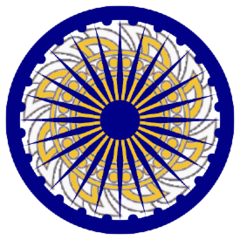Charsidhanism
This article is incomplete because it is pending further input from participants, or it is a work-in-progress by one author. Please comment on this article's talk page to share your input, comments and questions. Note: To contribute to this article, you may need to seek help from the author(s) of this page. |
Charsidhanism चरसिडानिज्म | |
|---|---|
 | |
| Adopted | October 17, 1946 |
| Ideology | Territorial Nationalism Rajyani Nationalism Monarchism Militarism |
| Country | |
Charsidhanism (Matrabashi: चरसिडानिज्म), sometimes referred to as "the four principles", is a rajyani ideology that, since independence in October 1946, has been the national ideology of the Kingdom of Rajyaghar. Charsidhanism, the implementation of the charsidhan philosophy, was developed during the Solarian War in a bid to ensure national unity following independence, to act against growing pan-satrian from neighbouring Ajahadya, and to provide military strength to protect against invasion. Specifically, charsidhanism was developed to encompass the four principles of territorial nationalism, rajyani nationalism, monarchism and militarism.
The absence of ethnic nationalism and religious nationalism from the ideology gained it support from the ethnnic minority groups in the south and east of Rajyaghar, particularly in Pinjar and Zulmat as well as support from the irfanic and badi groups across the country. The inclusion of monarchism was a compromise to the tulyatan majority who feared a minority head of state.
Origins
Four Principles
Territorial Nationalism
Rajyani Nationalism
Monarchism
Militarism
Usage in Rajyaghar
Criticism
Symbolism
The Charsidhan Chakra, the symbol of charsidhanism, features the Jhanda Chakra as well as a 24 spoked wheel. The Jhanda Chakra's inclusion was a reflection on its dominance throughout ancient rajyani history as well as its status as the first empire to control the vast majority of modern-rajyani territory. The wheel represented national unity with it unifying the 24 spokes, which represented the 24 Union States at the time of independence. At the time, Dalar Bewar was a province of the Union State of Zulmat and did not become a Union State in its own right until 1972.
When independence was first announced to be achieved upon the conclusion of the Solarian War, the nation's forefathers began to develop the symbols, flags and seals for the soon-to-be independent Rajyaghar. To promote charsidhan, it's symbol would be incorporated into the Royal Seal as well as feature on many of the Union State flags.




